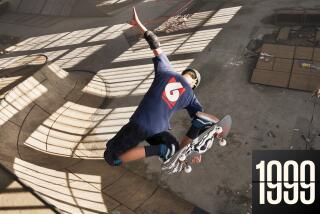Big-Air Fare
- Share via
The problem with Danny Way is, he has one of those imaginary, devilish little guys on one shoulder, “telling me to do things I probably shouldn’t be doing,” he says. But there’s nobody on the other shoulder, urging him not to do them.
As a result, the renowned skateboarder from Encinitas finds himself, at 30, fortunate to be standing and reasonably sound.
He broke his left wrist when he was 9, overshooting a vert ramp. He shattered his left elbow when he was 15 -- and still can’t straighten his arm. He has blown out ligaments in both knees and has left enough flesh on the pavement over the years to cover a skeleton.
Way, who is married and has two children, once dropped from a helicopter onto a ramp. He stuck the landing, then fell and messed up his shoulder.
He has plans for other wild rides, but this week, the 6-foot-1 Way, a giant in the minds of thousands of skateboarders, is focusing on mastering his latest creation.
It’s called the mega ramp. On it, skaters roll 50 to 70 feet down ramps, then take one of two jumps at speeds up to 50 mph, soar over gaps of either 50 or 70 feet, land on a downhill ramp that leads to a 30-foot quarterpipe ramp, on which they catch more big air and somehow maintain the poise to perform a trick and nail the landing.
That’s the objective, anyway. The board is sometimes lost or ditched in midair, and the skater is left to flail across the gap like a drunken Superman. Very few have had the opportunity to test their skills on the mega ramp -- which Way designed and had built two years ago at PointXCamp near Temecula -- and those who have will be showcasing their talents for the first time before the public this week during the X Games at Staples Center. There is a practice session Friday, and the finals are Sunday.
“Make no mistake, it is dangerous,” says Tony Hawk, 36, who will serve as commentator for vert-skating competition at the X Games. “People will be very surprised.”
Surprise registered on the faces of the six competitors as they repeatedly overshot the prime landing area during their first practice last Friday. One by one, they ditched their boards just before touching down, sliding or rolling to stops on the smooth veneered surface. One by one, they went back up and tried again.
Ultimately, they found their ideal takeoff points and began connecting, completing their runs in graceful displays.
One of the most adept was Bob Burnquist, 27, wearing what he called “a homemade bodysuit” of cloth and padding. Dusting off after a fall, he called the mega ramp the most exciting innovation skateboarding has ever seen -- a progression in vert that nobody but Way could have imagined.
“Danny is the light behind this whole thing,” Burnquist said, fixing a stare toward the top of the ramp. “You look at Danny and go, ‘Wow!’ If he can think of it and materialize it, then you see it’s possible. And if you have the skills, you go and follow him. But it’s not just look at Danny and go follow him, because it’s a pretty heavy place to be -- where Danny is.”
Not long afterward, Way was at the heaviest place of all, atop the 70-foot platform, eyeing the 70-foot gap.
Down Way went, and up Way went, holding his board to his feet with one hand, then letting go and flying headfirst to the landing ramp, where he slid to a stop, rose to his feet and smiled.
“Well, I know at least that I can clear the gap,” he said.
Back atop the ramp, he talked about the distance and quarterpipe height records he keeps setting. In June 2003 at PointX, he set the standard, covering a 75-foot gap while spinning a 720-degree turn and soaring 23 feet 6 inches above the quarterpipe.
Though Way was formerly a standout contest skater, he said contests stifled his creativity. He felt “caged in” on regular vert ramps. So, he designed the mega ramp and his main sponsor, DC Shoes, built it.
“On this, you feel as though you have no cage and no limit,” he said.
“You can go as big and as far and as crazy as you want.”
From atop the ramp, the jumps below look small, as though a skater could miss them, or worse, fly off one at an angle and end up in the Staples Center parking lot. In the gap are wood and debris, although there is padding before the landing ramp, in case a skater comes up short.
Told it looks like an Evel Knievel-type contraption, Way agreed.
“But the difference is that his were one-time deals, where you either made it or didn’t,” he said. “This is something you can control and get wired.”
It’s not unlike a big-air snowboard or motorcycle jump, he acknowledged. But skateboarders don’t have the benefit of foot straps or handlebars and seats. Hang time is such -- three to four seconds seems an eternity -- that skateboarders have a hard time maintaining a forward position in the air, so they’ll often turn 360s in flight.
The higher air on the quarterpipe enables greater creativity on that end too, Way said.
“Ever since I was a little kid, I had the mind-set to do my own tricks and moves,” he said. “I’ve always been inspired by guys that were innovators. A lot of guys follow other guys and mimic the things they see. I’ve just always felt that I want to stand on my own and be my own personality, and be respected in my own way, instead of looking like someone else.”
More to Read
Go beyond the scoreboard
Get the latest on L.A.'s teams in the daily Sports Report newsletter.
You may occasionally receive promotional content from the Los Angeles Times.






